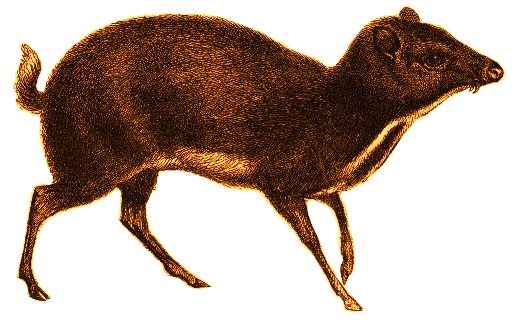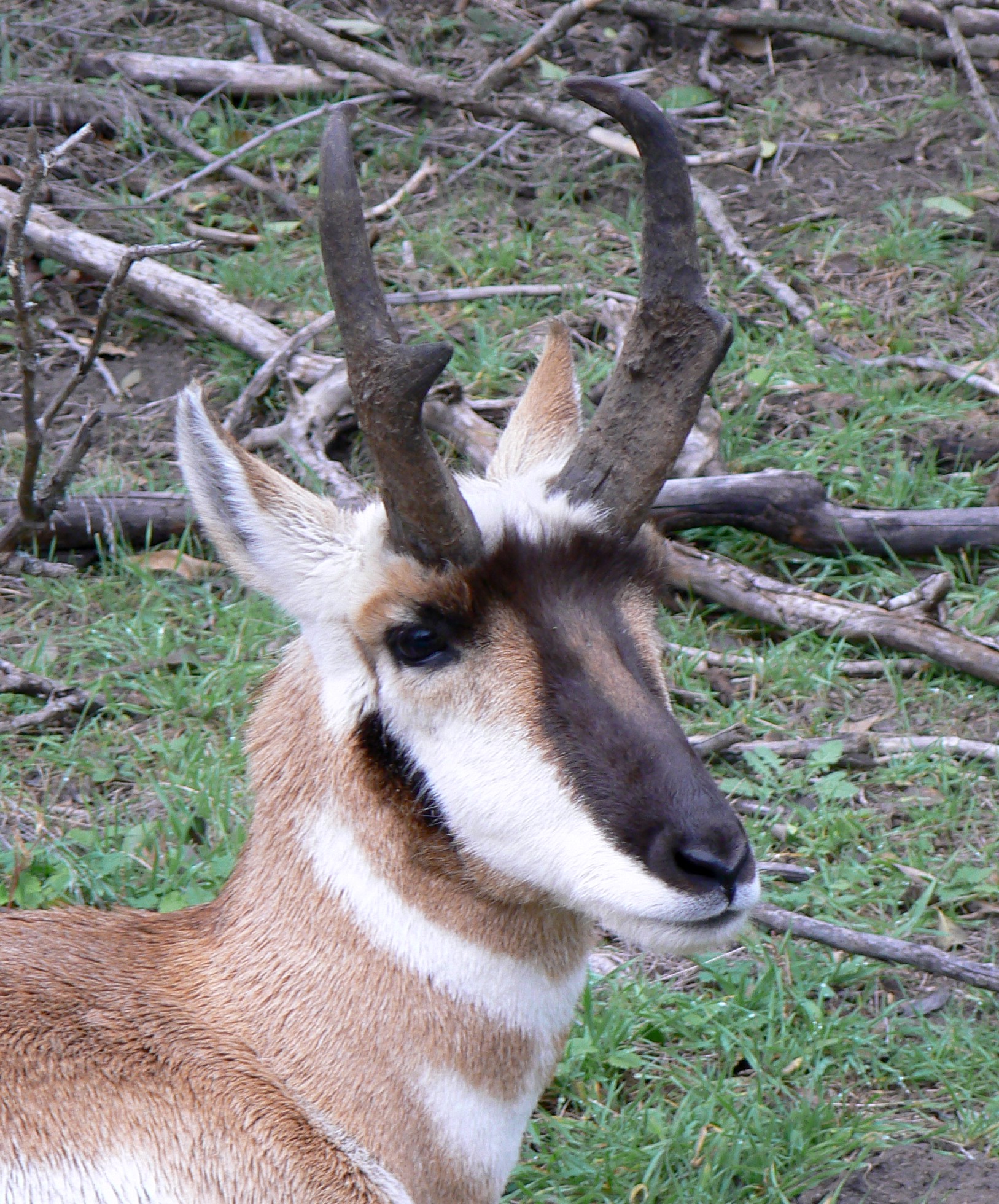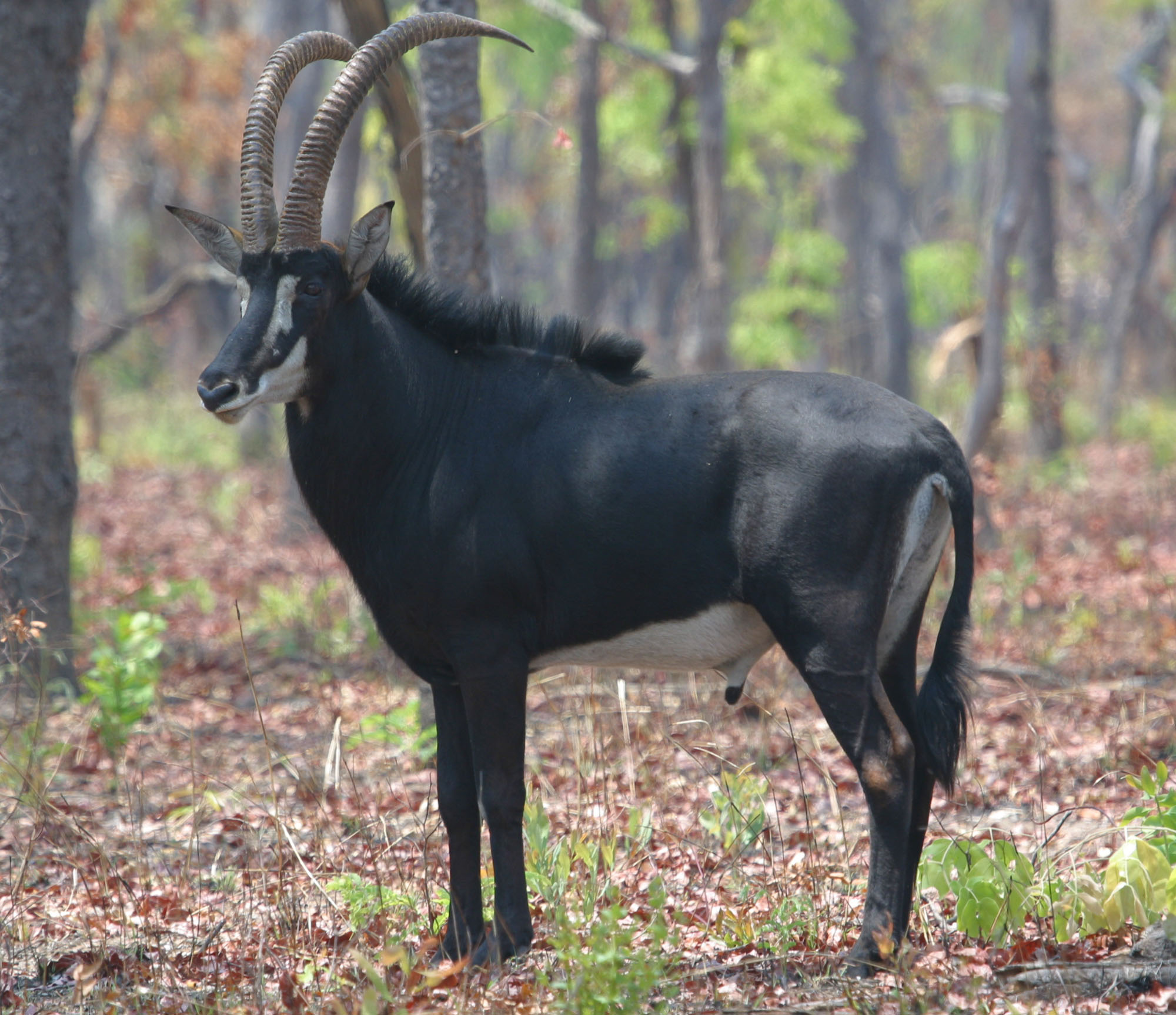|
Antilocapridae
The Antilocapridae are a family of ruminant artiodactyls endemic to North America. Their closest extant relatives are the giraffids. Only one species, the pronghorn (''Antilocapra americana''), is living today; all other members of the family are extinct. The living pronghorn is a small ruminant mammal resembling an antelope. Description In most respects, antilocaprids resemble other ruminants. They have a complex, four-chambered stomach for digesting tough plant matter, cloven hooves, and small, forked horns. Their horns resemble those of the bovids, in that they have a true horny sheath, but, uniquely, they are shed outside the breeding season, and subsequently regrown. Their lateral toes are even further diminished than in bovids, with the digits themselves being entirely lost, and only the cannon bones remaining. Antilocaprids have the same dental formula as most other ruminants: . Classification The antilocaprids are ruminants of the clade Pecora. Other extant pecor ... [...More Info...] [...Related Items...] OR: [Wikipedia] [Google] [Baidu] |
Pecora
Pecora is an Order (biology), infraorder of Artiodactyla, even-toed hoofed mammals with ruminant digestion. Most members of Pecora have cranial appendages projecting from their frontal bones; only two extant genera lack them, ''Hydropotes'' and ''Musk Deer, Moschus''. The name "Pecora" comes from the Latin word , which means "cattle".Bubenik, A. Epigenetical, Morphological, Physiological, and Behavioral Aspects of Evolution of Horns, Pronghorns, and Antlers. in ''Horns, Pronghorns, and Antlers''. G. Bubenik and A. Bubenik eds. Springer-Verlag. New York. 1990 Although most pecorans have cranial appendages, only some of these are properly called "horns", and many scientists agree that these appendages did not arise from a common ancestor, but instead evolved independently on at least two occasions.Janis, C., K. Scott. The Interrelationships of Higher Ruminant Families with Special Emphasis on the Members of the Cervoidea. ''American Museum Novitates''. 2893: 1-85. 1987. http://digit ... [...More Info...] [...Related Items...] OR: [Wikipedia] [Google] [Baidu] |
Ruminantia
Ruminants are herbivorous grazing or browsing artiodactyls belonging to the suborder Ruminantia that are able to acquire nutrients from plant-based food by Enteric fermentation, fermenting it in a specialized stomach prior to digestion, principally through microbial actions. The process, which takes place in the front part of the digestive system and therefore is called foregut fermentation, typically requires the fermented ingesta (known as cud) to be regurgitated and chewed again. The process of rechewing the cud to further break down plant matter and stimulate digestion is called rumination. The word "ruminant" comes from the Latin ''ruminare'', which means "to chew over again". The roughly 200 species of ruminants include both domestic and wild species. Ruminating mammals include cattle, all domesticated and wild bovines, goats, sheep, giraffes, deer, gazelles, and antelopes.Fowler, M.E. (2010).Medicine and Surgery of Camelids, Ames, Iowa: Wiley-Blackwell. Chapter 1 General B ... [...More Info...] [...Related Items...] OR: [Wikipedia] [Google] [Baidu] |
Ruminant
Ruminants are herbivorous grazing or browsing artiodactyls belonging to the suborder Ruminantia that are able to acquire nutrients from plant-based food by fermenting it in a specialized stomach prior to digestion, principally through microbial actions. The process, which takes place in the front part of the digestive system and therefore is called foregut fermentation, typically requires the fermented ingesta (known as cud) to be regurgitated and chewed again. The process of rechewing the cud to further break down plant matter and stimulate digestion is called rumination. The word "ruminant" comes from the Latin ''ruminare'', which means "to chew over again". The roughly 200 species of ruminants include both domestic and wild species. Ruminating mammals include cattle, all domesticated and wild bovines, goats, sheep, giraffes, deer, gazelles, and antelopes.Fowler, M.E. (2010).Medicine and Surgery of Camelids, Ames, Iowa: Wiley-Blackwell. Chapter 1 General Biology and ... [...More Info...] [...Related Items...] OR: [Wikipedia] [Google] [Baidu] |
Giraffidae
The Giraffidae are a family (biology), family of ruminant artiodactyl mammals that share a recent common ancestor with deer and bovids. This family, once a diverse group spread throughout Eurasia and Africa, presently comprises only two extant genera, the giraffe (between one and eight, usually four, species of ''Giraffa'', depending on taxonomic interpretation) and the okapi (the only known species of ''Okapia''). Both are confined to sub-Saharan Africa: the giraffe to the open savannas, and the okapi to the dense rainforest of the Democratic Republic of the Congo, Congo. The two genera look very different on first sight, but share a number of common features, including a long, dark-coloured tongue, lobed canine teeth, and horns covered in skin, called ossicones. Taxonomy Evolutionary background The giraffids are ruminants of the clade Pecora. Other extant pecorans are the families Antilocapridae (pronghorns), Cervidae (deer), Moschidae (musk deer), and Bovidae (Bovini, cattl ... [...More Info...] [...Related Items...] OR: [Wikipedia] [Google] [Baidu] |
Giraffe
The giraffe is a large Fauna of Africa, African even-toed ungulate, hoofed mammal belonging to the genus ''Giraffa.'' It is the Largest mammals#Even-toed Ungulates (Artiodactyla), tallest living terrestrial animal and the largest ruminant on Earth. It is classified under the Family (biology), family Giraffidae, along with its closest extant relative, the okapi. Traditionally, giraffes have been thought of as one species, ''Giraffa camelopardalis'', with nine subspecies. Most recently, researchers proposed dividing them into four Neontology#Extant taxa versus extinct taxa, extant species which can be distinguished by their fur Animal coat, coat patterns. Six valid Lists of extinct species, extinct species of ''Giraffa'' are known from the fossil record. The giraffe's distinguishing characteristics are its extremely long neck and legs, horn-like ossicones, and spotted coat patterns. Its scattered range extends from Chad in the north to South Africa in the south and from Niger in ... [...More Info...] [...Related Items...] OR: [Wikipedia] [Google] [Baidu] |
Pronghorn
The pronghorn (, ) (''Antilocapra americana'') is a species of artiodactyl (even-toed, hoofed) mammal indigenous to interior western and central North America. Though not an antelope, it is known colloquially in North America as the American antelope, prong buck, pronghorn antelope, and prairie antelope, because it closely resembles the antelopes of the Old World and fills a similar ecological niche due to parallel evolution. It is the only surviving member of the family Antilocapridae. During the Pleistocene epoch, about 11 other antilocaprid species existed in North America, many with long or spectacularly twisted horns.Smithsonian Institution. North American MammalsPronghorn ''Antilocapra americana'' Three other genera ('' Capromeryx'', '' Stockoceros'' and '' Tetrameryx'') existed when humans entered North America but are now extinct. The pronghorn's closest living relatives are the giraffe and okapi. See Fig. S10 in Supplementary Information. The antilocaprids are part of ... [...More Info...] [...Related Items...] OR: [Wikipedia] [Google] [Baidu] |
Artiodactyla
Artiodactyls are placental mammals belonging to the order (biology), order Artiodactyla ( , ). Typically, they are ungulates which bear weight equally on two (an even number) of their five toes (the third and fourth, often in the form of a hoof). The other three toes are either present, absent, vestigial, or pointing posteriorly. By contrast, most perissodactyls bear weight on an odd number of the five toes. Another difference between the two orders is that many artiodactyls (except for Suina) digest plant cellulose in one or more stomach chambers rather than in their intestine (as perissodactyls do). Molecular biology, along with new fossil discoveries, has found that cetaceans (whales, dolphins, and porpoises) fall within this taxonomic branch, being most closely related to Hippopotamidae, hippopotamuses. Some modern taxonomists thus apply the name Cetartiodactyla () to this group, while others opt to include cetaceans within the existing name of Artiodactyla. Some researchers ... [...More Info...] [...Related Items...] OR: [Wikipedia] [Google] [Baidu] |
Caprinae
The subfamily Caprinae, also sometimes referred to as the tribe Caprini, is part of the ruminant family Bovidae, and consists of mostly medium-sized bovids. A member of this subfamily is called a caprine. Prominent members include sheep and goats, with some other members referred to as goat antelopes. Some earlier taxonomies considered Caprinae a separate family called Capridae (with the members being caprids), but now it is usually considered either a subfamily within the Bovidae, or a tribe within the subfamily Antilopinae of the family Bovidae, with caprines being a type of bovid. Characteristics Although most goat-antelopes are gregarious and have fairly stocky builds, they diverge in many other ways – the muskox (''Ovibos moschatus'') is adapted to the extreme cold of the tundra; the mountain goat (''Oreamnos americanus'') of North America is specialised for very rugged terrain; the urial (''Ovis orientalis'') occupies a largely infertile area from Kashmir to Ira ... [...More Info...] [...Related Items...] OR: [Wikipedia] [Google] [Baidu] |
Bovidae
The Bovidae comprise the family (biology), biological family of cloven-hoofed, ruminant mammals that includes Bos, cattle, bison, Bubalina, buffalo, antelopes (including Caprinae, goat-antelopes), Ovis, sheep and Capra (genus), goats. A member of this family is called a bovid. With 143 Extant taxon, extant species and 300 known Extinction, extinct species, the family Bovidae consists of 11 (or two) major subfamilies and thirteen major tribes. The family evolved 20 million years ago, in the early Miocene. The bovids show great variation in size and Fur, pelage colouration. Except some Polled livestock, domesticated forms, all male bovids have two or more horn (anatomy), horns, and in many species, females possess horns, too. The size and shape of the horns vary greatly, but the basic structure is always one or more pairs of simple bony protrusions without branches, often having a spiral, twisted or fluted form, each covered in a permanent sheath of keratin. Most bovids bear 30 to ... [...More Info...] [...Related Items...] OR: [Wikipedia] [Google] [Baidu] |
Antelope
The term antelope refers to numerous extant or recently extinct species of the ruminant artiodactyl family Bovidae that are indigenous to most of Africa, India, the Middle East, Central Asia, and a small area of Eastern Europe. Antelopes do not form a monophyletic group, as some antelopes are more closely related to other bovid groups, such as bovines, goats, and sheep, than to other antelopes. A stricter grouping, known as the true antelopes, includes only the genera '' Gazella'', '' Nanger'', '' Eudorcas'', and '' Antilope''. One North American mammal, the pronghorn or "pronghorn antelope", is colloquially referred to as the "American antelope", despite the fact that it belongs to a completely different family ( Antilocapridae) than the true Old-World antelopes; pronghorn are the sole extant member of an extinct prehistoric lineage that once included many unique species. Although antelope are sometimes referred to, and easily misidentified as, "deer" ( cervids), true ... [...More Info...] [...Related Items...] OR: [Wikipedia] [Google] [Baidu] |
Antilocapra
''Antilocapra'' is a genus of the family Antilocapridae, which contains only a single living species, the pronghorn ''(Antilocapra americana)''. Another species, the Pacific pronghorn, lived in California during the Late Pleistocene and survived as recently as 12,000 BP. The name means "antelope-goat". ''Antilocapra'' is the only surviving genus of pronghorn, though three other genera (''Capromeryx'', ''Stockoceros'' and ''Tetrameryx'') existed in North America North America is a continent in the Northern Hemisphere, Northern and Western Hemisphere, Western hemispheres. North America is bordered to the north by the Arctic Ocean, to the east by the Atlantic Ocean, to the southeast by South Ameri ... up until the end of the Pleistocene. References Mammal genera Mammal genera with one living species Pronghorns Taxa named by George Ord {{eventoedungulate-stub ... [...More Info...] [...Related Items...] OR: [Wikipedia] [Google] [Baidu] |









